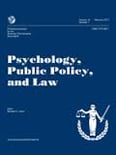 Psychology has had several influences on prisons and imprisonment. This article reflects on four of these. This is a summary of a recently published article in Psychology, Public, Policy, and Law. Below is a summary of the research and findings as well as a translation of this research into practice.
Psychology has had several influences on prisons and imprisonment. This article reflects on four of these. This is a summary of a recently published article in Psychology, Public, Policy, and Law. Below is a summary of the research and findings as well as a translation of this research into practice.

Featured Article | Psychology, Public Policy, and Law, 2017, Vol. 23, No. 4, 478-489
The History and Future of Prison Psychology
Authors
David M. Bierie, University of Maryland, College Park
Ruth E. Mann, Her Majesty’s Prison and Probation Service, London, England
Abstract
Prisons are the quintessential government institution, with almost complete control over the lives of the people compelled to spend time in them. Depending on how they are run and what services they provide, they have the potential to change people’s paths in life for the better or the worse, or indeed to leave people untouched. Furthermore, an enormous number of people spend time in prisons, particularly in the United States, so that the impact of imprisonment has serious consequences for society. In this article, we reflect on some of the major influences that psychology has had on prisons and imprisonment. We consider the importance of the scientist-practitioner model and the extent to which psychological evidence has permeated prison policy. We illustrate with four examples of how psychologists have contributed to understanding and influencing prisons: the Stanford Prison Experiment, the scientist-practitioner work of Hans Toch, the concepts of legitimacy and procedural justice, and the risk, needs, and responsivity principles of correctional rehabilitation. Looking to the future, we imagine how psychologically informed data science could expand its reach, and discuss ways in which prison psychologists could up our game in effectively communicating and embedding the findings of psychological science.
Keywords
Prison, prison psychology, scientist practitioner, psychology of imprisonment
Summary of the Research
“Psychology has continued to generate critical and important insights in correctional practices, including several paradigm shifts in the relatively recent past. Likewise, prisons remain a fertile contextual ground that challenges psychologists to sharpen their ideas, develop theories, and test and refine interventions with respect to human behavior.” (p. 479).
“Prisons today continue to represent the quintessential context in which government has unparalleled access to, and obligation to intervene in, the lives of individuals as well as opportunity to control them. […] The saturation of
government in restricting or imposing choices on individuals in prison is more all-encompassing than nearly any other social location in Western societies. This enormous reach means that the competence and benevolence, or lack thereof, of government is magnified in this context.” (p. 480).
“Psychology and psychologists interact with prisons in a variety of ways. First, and perhaps most pervasive, they engage in clinical work within prisons. […] Second, psychologists often act as researchers and translators of correctional science, be it social, cognitive, or other specific subdisciplines. […] Third, the term refers to those who create, refine, or use forensic tools such as risk screening instruments, polygraph, interviews, and similar tactical applications of the field.” (p. 479).
“Psychologists have been key to the creation and/or delivery of scientific information that served as turning points in corrections history. They have both assisted in the introduction of useful insights and also helped buffer against erroneous and sometimes dangerous turning points in the field.” (p. 481)
The Psychology of Staff-Prisoner Relationships: A Classic Psychological Experiment
“The SPE [the Stanford Prison Experiment] has been widely criticized (e.g., Kulig, Pratt, & Cullen, 2016) but remains a landmark experiment with a powerful point to make about the dynamics of relationships within a prison setting. (p. 481).
“The SPE produced two interrelated paradigm shifts. First, it showed that the problem of abuse and violence between staff and prisoners is a function of structure. […] Second, it revealed, powerfully, that prisoners and guards were not so very different from each other (or the rest of us). […] [P]rison to be a place with more potential for behavioral change than previously presumed.” (p. 481).
Hans Toch and the Popularization of the Scientist-Practitioner Model
“The scientist-practitioner approach assumes, first, that scientific insights translate into practice with more fidelity when delivered by a scientist, and, second, that one asks better questions and pursues better science when deeply aware of the nuances of applied practice. Its derivative, the practitioner-scholar model, shares the same fundamental assumption: that applied psychological practice attends to, and is driven by, scholarly understanding of the scientific evidence base.” (p. 482).
“Toch set the standard for psychologists in prisons to understand and embrace this approach. He used psychological science to address many problems with and in prisons, and he was unremitting in his abhorrence of inhumane or harmful practices in prisons that were justified in the name of psychology but that actually represented junk science or nonscholarly misapplications of psychological theory.” (p. 482).
Legitimacy and Procedural Justice
“[P]eople are most likely to perceive the authorities as legitimate when they are treated with procedural justice: when the authority acts respectfully and ethically (e.g., sanctions are reasonable), when decisions are perceived as fair and transparent, when the individual has a voice in the decision-making process, and when there is an ability to appeal decisions believed inaccurate. When people perceive the authorities as legitimate, people are more motivated to obey the law—even when it is not convenient to do so. Similarly, people tend not to comply with, or even become defiant toward, authority figures perceived as procedurally unjust (Sherman, 1993).” (p. 482).
“The concepts of procedural justice are exceptionally important to prisons. In prisons, decisions and acts of authority are pervasive and, because of diminished liberty, even the most trivial acts of authority take on magnified relevance.” (p. 482).
“[P]risons are run in procedurally just ways, the result is reduced prison violence, increased prosocial change, and lowered recidivism. Procedural justice is also important to prison staff, where it is associated with less punitive and more rehabilitative attitudes as well as greater job satisfaction” (p. 482).
“[T]he actions of every correctional officer and administrator matter in the reform effort because they provide pervasive, constant, meaningful exchanges with inmates. The daily duties of correctional officers—instructing an inmate to pack their cell and move to a new pod, to report to a new job post, to clean up a lunch another person spilled, that there will be no trip to the library today, and that visits are cancelled— can have a tremendous impact on prison order and inmate rehabilitation depending on whether that instruction is delivered with procedurally just connotations (e.g., reasonable orders, fairly administered to all, allowing an inmate to explain an objection if they have one and to file a complaint later if they felt the order was problematic).” (p. 482).
The Risk- Need- Responsivity (RNR) Model of Effective Rehabilitation
“A plethora of studies and meta-analyses have supported the RNR principles, and their reach has extended to include the development of robust risk and need assessment tools as well as the implementation and evaluation of literally hundreds of rehabilitation programs (Bonta & Andrews, 2016).” (p. 483).
“The RNR model has pushed prisons to focus their various services on the people who need them the most and to provide services in the form that will be most effective. It also led to a much-needed refocus on the scientist-practitioner principles of evidence-based practice, which had, to some extent, been dulled in the 1970s and 1980s in favor of more intuitive approaches (Benjamin, 2006).” (p. 483)
“What lessons can we learn from the failure of prison psychology to fully embed its knowledge into prison policy? The first lesson here is that intuition is a constant and, at times, harmful antagonist to science in corrections. […] The second key lesson appears to be one of strategy. […] The third lesson has to do with the quality of scientific research.” (p. 483-484)
“Overall, the history of psychologists in prisons described above paint a picture of great promise, as this history has been, on the whole, positive. The dual legacy of “presence” and “paradigms” associated with psychologists helps explain this general trend. But the failures in the history of psychology and prisons are also informative.” (p. 484)
Translating Research into Practice
“Psychological research on imprisonment should be driven by a genuine concern for the people who live in prisons, recognizing that they deserve the best that psychology has to offer, rather than being mere research subjects for matters of academic interest.” (p. 482).
“Zimbardo (2008, 2016) has proposed that it should be understood as a failure of leadership and an underestimation of the power of the situation and the system to produce behaviors that, as human beings, we do not like to think we are capable of. In particular, Zimbardo has stressed that a prison system needs to have a clear, consistent, and unambiguous purpose and set of values.” (p. 481).
“By merely answering formal inmate complaints in a timely way, for example, prisons tend to observe significant declines in serious prison violence (Bierie, 2013). By providing clean, quiet, and humane facilities, prisons tend to experience significantly less prison disorder (Bierie, 2012).” (p. 482).
“It is important that the field produce high-quality and relevant scientific facts. It is also important that the field engage in active effort to communicate the content of science to all of those working with prisons and to explain why those facts are valuable” (p. 484)
Other Interesting Tidbits for Researchers and Clinicians
“[Zimbardo’s] instruction to the “guards” in the SPE created ambiguity for the guards in what they were supposed to achieve, and this led them to overemphasize control at the expense of decency and humanity. In turn, the “prisoners” either retaliated against the efforts to dominate them or submissively accepted them. Neither reaction was conducive to a rehabilitative (corrective) experience of imprisonment.” (p. 481).
“[The RNR model] has also been heavily critiqued, leading to vigorous debate about, for example, the value of individualization versus prescription in how services are delivered, the similarities and differences between risk factors for men and women, the possibility of expanding RNR principles beyond formal interventions to less formal interactions in correctional settings, and the potential for better outcomes that might result from taking a strengths based rather than risk-based approach.” (p. 483).
“[T]he field needs to pursue comprehensive research agendas in terms of questions asked and methods used in order for prison executives to make better decisions and to fully engage social sciences.” (p. 484).
“It is also important that the field engage in active effort to communicate the content of science to all of those working with prisons and to explain why those facts are valuable.” (p. 484).
Join the Discussion
As always, please join the discussion below if you have thoughts or comments to add!






















